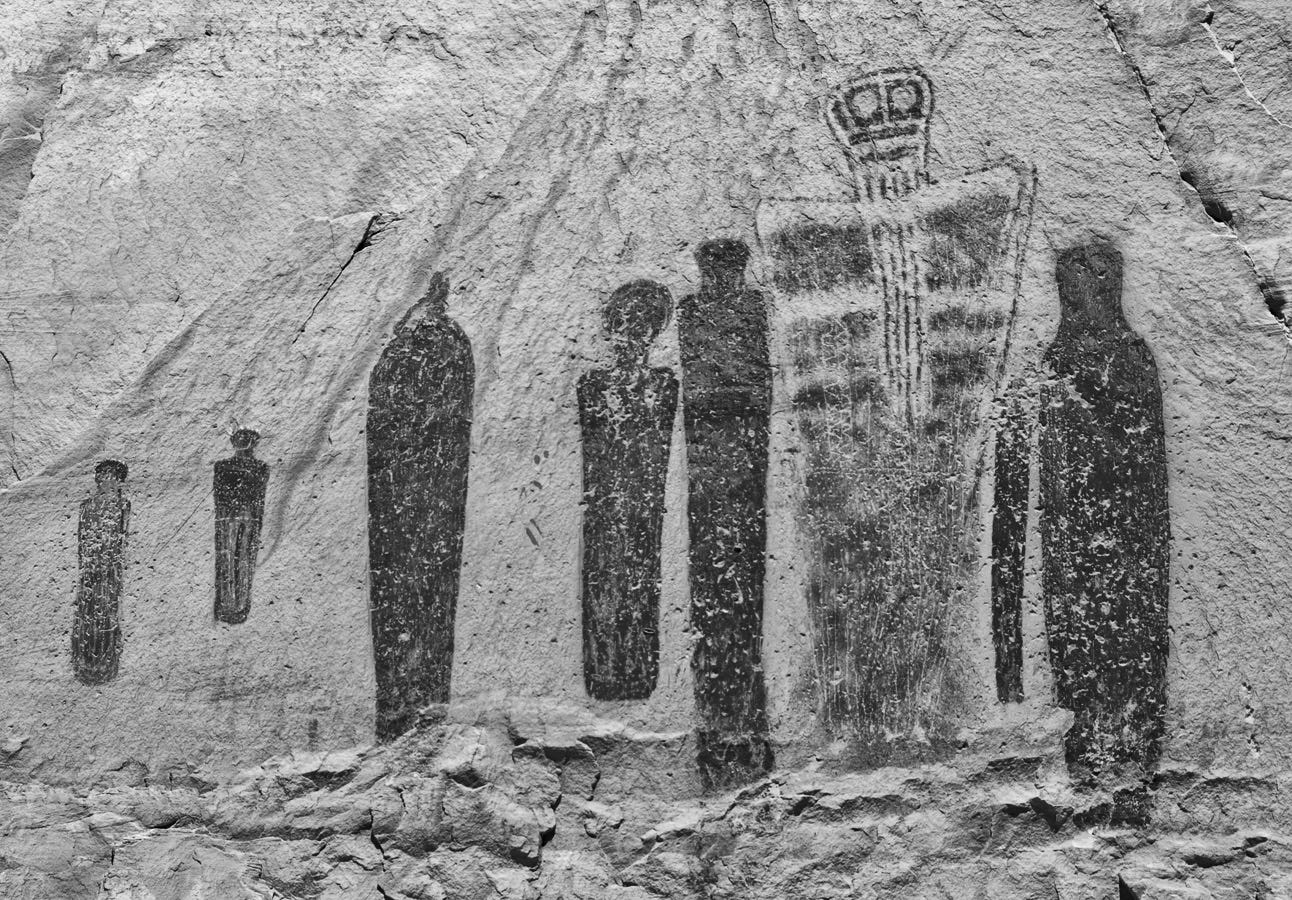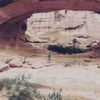The West's oldest surviving literature is being destroyed
On petroglyphs, language and the inexpressible
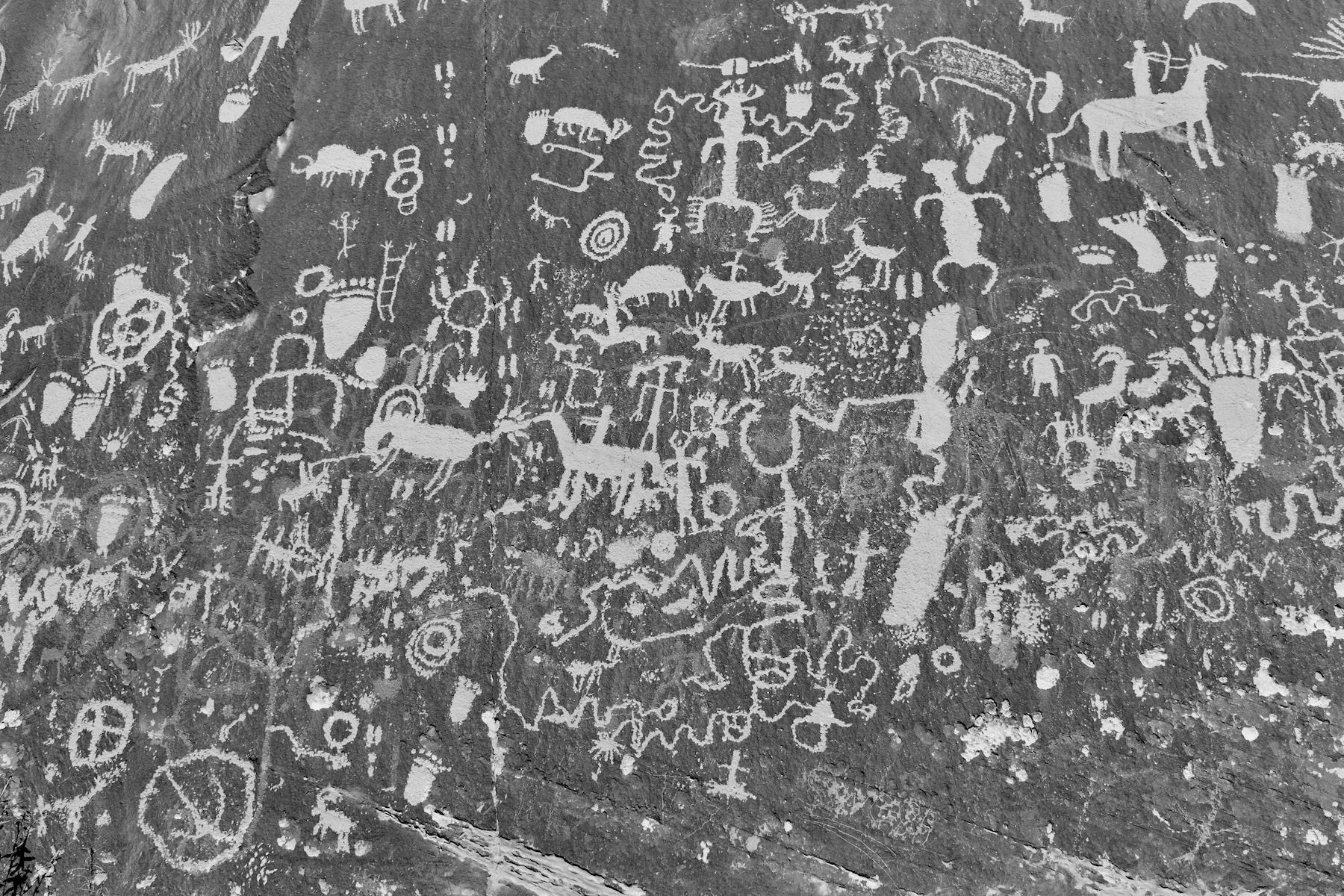
It’s easy to miss the turn for the Newspaper Rock State Historical Monument, tucked into a shady gulch along Utah State Route 211, a road most frequently traveled by rock climbers and visitors to Canyonlands National Park. The parking lot is several times larger than the monument itself, which consists of a short path to a cliff wall full of petroglyphs carved over the centuries by the region’s Indigenous peoples. More than 600 individual glyphs have been chipped into the desert varnish, depicting everything from bear prints and horned humanoid figures to the arrival of horses in the 16th century and a wide range of inscrutable squiggles and symbols. The rock’s oldest glyphs are believed to be roughly 2,000 years old, and only a short railing and a few feet of space separate visitors from two millennia of recorded Native American history.
Perhaps unsurprisingly, then, the site has been repeatedly vandalized over the years. CD Gonsales 6.3.54 reads one inscription. JEAИ R reads another. Small initials and dates abound: KH, JER, 1902. In a dozen places, words have been etched into the rock and then scratched out.
Newspaper Rock is an especially easy target for vandals, but it’s far from unique. Wherever pieces of ancient rock art — carved petroglyphs or painted pictographs — are on display throughout the West, the graffiti isn’t far away. There are tens of thousands of these sites, many of them remote and undocumented, but they’re all similarly fragile, and when damage is done it’s often irreversible. In the long run, it’s the fate of all rock art to be weathered away by the sun and the wind and the rain, but much of it won’t get that chance; erasure will come spray-paint can by spray-paint can, climbing bolt by climbing bolt, fracking pad by fracking pad.
The problem is getting worse. In Utah’s Capitol Reef National Park, officials said in 2016 that the number of vandalism cases had increased to “dozens upon dozens a year as opposed to the five or six a year we used to handle.” Maybe the rise in vandalism is simply a function of the soaring number of visitors to public lands in Utah and elsewhere; maybe it’s something more. Many of the more remote rock art panels scattered across the Southwest are used for target practice and riddled with bullet holes. Swastikas were reportedly spray-painted on sacred rock art panels near Provo last year. In April, an ancient petroglyph site near Moab, Birthing Rock, was defaced by vandals who scratched the words “white power” over two of its anthropomorphic figures. The vandalism came only days after former Republican senator and CNN analyst Rick Santorum made headlines by saying that United States had “birthed a nation from nothing” in a speech at a conservative gathering: “I mean, there was nothing here,” he said. “Yes, we have Native Americans, but candidly, there isn't much Native American culture in American culture.”
“The crisis isn't necessarily rock art vandalism,” Don Montoya, an archaeologist with the Bureau of Land Management, told Moab public radio station KZMU in May. “Rock art vandalism is reflective of something else.”
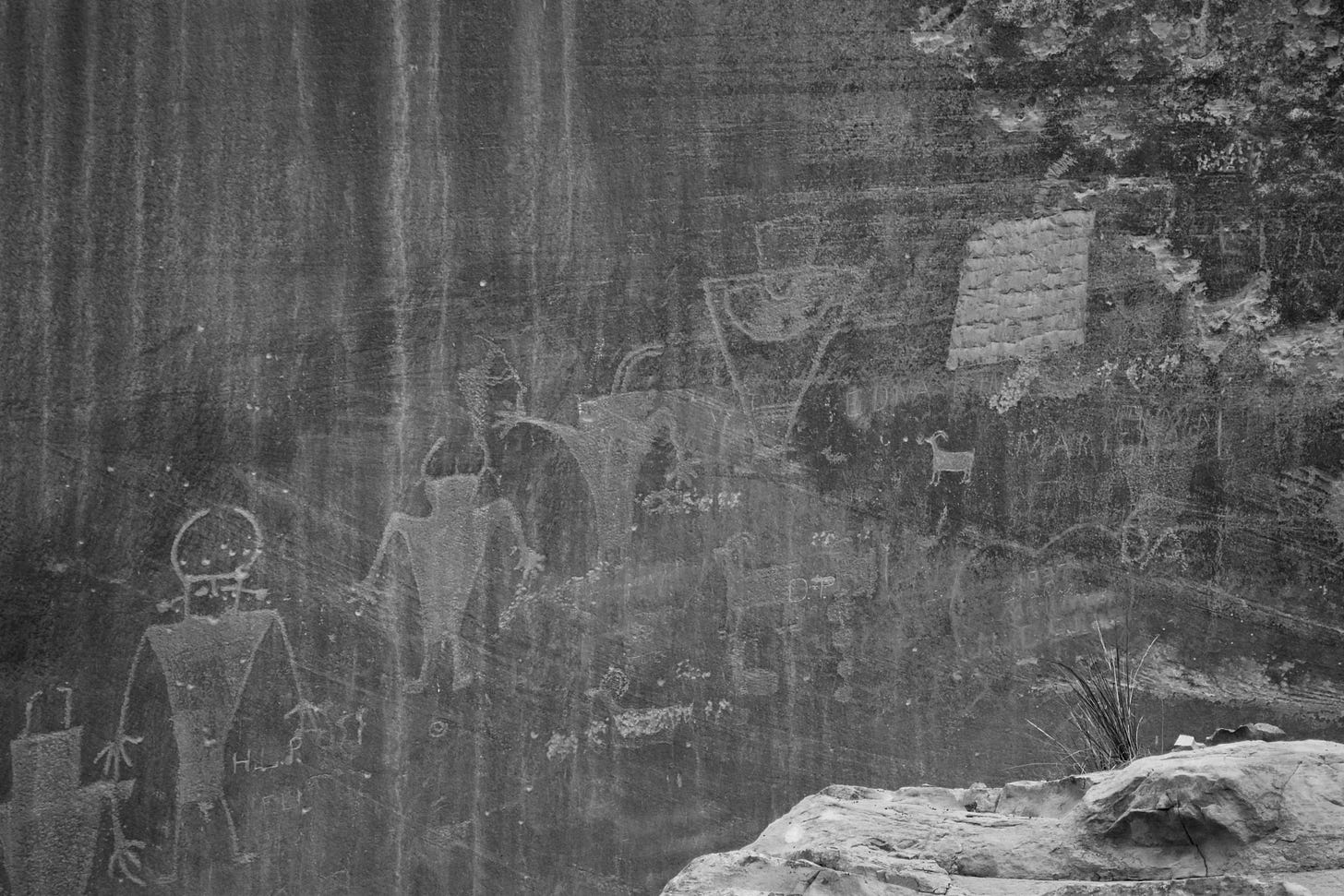
When I look at a petroglyph, I feel an urge to decipher its symbols and understand its meaning — a feeling that I don’t entirely trust. Is it a connective, empathetic impulse, or an intrusive, colonizing one? Who says I’m entitled to grasp exactly what’s meant by every glyph and painting, which are broadly thought to have often been freighted with sacred religious value? In any case, it’s a common feeling. “A lot of people want to know what a rock art panel means ‘up front’ and spend a lot of time trying to figure it out,” said the late Ute elder Clifford Duncan, as quoted by archaeologist Carol Patterson in her research on the rock art of Western Colorado. “But we are told not to bother with all that because it’s depicting a different world.”
Unfortunately for the would-be Southwestern rock-art decoder, we know little not only about the symbols themselves, but about many of the Indigenous cultures that left them behind. While what we might call modern archaeological inquiry has been going on in the West for a century and a half, there’s still a remarkable lack of consensus on some of the most basic questions about its precolonial history. We struggle even to put names to many of the peoples who once called the region home, classify them in relation to one another, or map their territories. Who were the Ancestral Puebloans — a group formerly called the Anasazi, for the Navajo word for “ancient enemy”? Were the “Fremont” Indians of Utah, named for the river along which their ruins were first discovered, a distinct culture group or simply a northern branch of the Ancestral Puebloans? Why did so many of these groups build high cliff dwellings and granaries in seemingly impossible-to-reach places?
And more than anything: What became of them? The same conditions that made it possible, and perhaps necessary, for the Indigenous peoples of the Interior West to produce such a large body of rock art — a sparse and rocky landscape, an arid climate, lifeways that depended on precise navigation and mastery of both — appear to have made for a precarious existence for their societies. What caused much of the Southwest’s population to disappear from the archaeological record around the 14th century? What are we to make of the disparate, often conflicting stories of the Old Ones that have been passed down through the oral traditions of modern Puebloans and other Southwestern tribes?
Given the long history of destruction and erasure of Western rock art, archaeologists may have wasted precious decades in initially refusing to take the study of petroglyphs and pictographs seriously. For most of the 20th century, the field, taking after early modern practitioners like Alfred Kidder and J.O. Brew, became dismissive of the etchings and paintings they found in or near ruins, part of a larger backlash that similarly ignored more subjective sources like tribal oral histories in favor of hard physical data gleaned through stratigraphic excavation. It’s easy, of course, to glimpse in these dismissals a racist disbelief that Indigenous cultures were capable of producing anything more sophisticated than meaningless doodles or, at best, a kind of shamanistic “hunting magic.”
This chronic neglect by archaeology’s gray eminences left it to an evolving cast of upstarts, amateurs and misfits to develop the study of rock art from scratch. “Historically ‘Dirt Archaeologists,’ i.e., men, did not consider rock art worthy of study,” writes New Mexico artist and rock art preservationist Katherine Wells in her 2011 memoir, Life on the Rocks. “Petroglyphs and pictographs were more suitable as a subject of inquiry for women or dilettantes.” Polly Schaafsma, an archaeologist whose work since the 1970s is credited with “chang[ing] the long-held view that rock art is idiosyncratic and difficult, if not impossible, to date and interpret,” told Pasatiempo as recently as 2016 that many in her field still “harbor the notion that image-making is a whimsical thing and brush it off.”
Much of Schaafsma’s early work, as she writes in a 2013 monograph, was concerned with the kind of “data gathering and classification … common to investigations in a new field of inquiry.” But gradually she and others in the field have waded into more interpretive analyses, often in consultation or partnership with modern Indigenous tribes, part of a broader trend within archaeology in recent decades towards a greater willingness to incorporate ethnographic information like tribal histories and interviews with living tribal elders.
Of course, in the study of rock art and beyond, collaboration between white researchers and Indigenous people is a fraught subject, to say the least. “Indians have been cursed above all other people in history. Indians have anthropologists,” the Standing Rock Sioux polemicist Vine Deloria Jr. wrote in 1969. Especially for the Zuni and other Puebloan peoples whose ancestors left behind so much of the West’s surviving rock art, a series of depredations and betrayals by early modern ethnographers in the late 19th and early 20th centuries have led to a deep distrust of outsiders and the careful guarding of ancestral knowledge. Early forays into interpretive rock-art archaeology are littered with tut-tutting over the confusing, often contradictory meanings attributed to the same symbols by different ethnographic sources, with little thought given to how much of the confusion might have been deliberate.
Fittingly, one of the most fascinating studies of rock art to date came from someone uniquely positioned to synthesize scientific and folk-interpretive approaches: LaVan Martineau, a white man who was adopted and raised by members of the Southern Paiute tribe following the death of his parents in the 1940s. Armed with both a deep knowledge of Paiute and other tribal traditions and a background in cryptanalysis gained during his service in the U.S. Air Force, Martineau dedicated much of his life to deciphering the petroglyphs and pictographs of the Southwest, publishing his opus, The Rocks Begin to Speak, in 1973.
Among the easiest and earliest classifications made in the study of rock art was between representational and abstract figures, with recognizable images of humans and animals belonging to the former category and everything else lumped in together under the latter. Martineau, however, rejected this framework more or less completely, arguing that petroglyphs and pictographs should instead be considered “rock writing,” a sophisticated semasiographic language system that was legible to Indigenous peoples across vast distances of time and space. Expanding on previous work by the 19th-century ethnographer Garrick Mallery, Martineau hypothesized that the meanings of many rock art symbols could be derived from corresponding gestures in the Native American sign language known to have been used for centuries as a lingua franca among Western and Plains tribes: an X symbol or crossed hands to mean trade, horns or curved fingers to mean strong, and so on. In the sheep, deer and other four-legged animal shapes so ubiquitous in Western rock art panels, Martineau saw not hunting rituals but a “simple method with which to express action or direction” that couldn’t be easily encoded into bipedal anthropomorphic forms.
Martineau worked closely with members of the Paiute, Ute, Apache and other Native American tribes, and had some self-evident successes in “deciphering” panels within a limited geographic and cultural scope. But his more ambitious theories never gained purchase in academic circles, and he did himself no favors by speculating at length, in the final chapters of The Rocks Begin to Speak, about the existence of a kind of primordial “universal pictography” from which Native American rock writing, along with Egyptian, Sumerian, Chinese and other Old World glyph systems, emerged. For a discipline striving to prove that it could be taken seriously, Martineau’s independent research strayed too far into what another armchair rock-art scholar, Joseph J. Snyder, once called the “nightmare of alleged interplanetary visits, Phoenician trading expeditions, and the like.”
If nothing else, Martineau, who died in 2000, was admirably candid about his “motive for attempting to defend the American Indian amidst this unfortunate neglect,” as he put it. “The taking of Indian lands to satisfy the early colonizers’ insatiable quest for land was often rationalized with the excuse that the Indians were uncivilized savages,” he wrote. “It thus became convenient to ignore Indian pictography, or to classify it as crude caveman scribbling which only the writer himself could understand.” Though he has his defenders, including Patterson, the evidence for a rock-writing system that was as widely and enduringly intelligible as Martineau imagined it is thin — and, as some of his critics have noted, it’s a very Western definition of civilization that considers only literate peoples as advanced enough to deserve their sovereignty.
The Rocks Begin to Speak was Martineau’s last published work, though his family, spurred on by a small community of devotees, has promised to digitize and release much of the extensive research he left behind. In the end, the lack of success that his interpretive model has had in decoding rock-art panels from disparate regions and eras speaks for itself — and when push came to shove, Martineau himself was perhaps more circumspect about his more grandiose theorizing than he’s given credit for. “The total of all known symbols collected by [scholars] does not amount to very much,” Martineau wrote in one of his book’s closing chapters. “Those examples which might have aided greatly in our study are sadly lacking, and we are left with only a smattering of what is needed to effectively read the bulk of Indian pictographic symbols.” For all practical purposes, little separates these visions of a lost rock-writing vocabulary from the simpler, less controversial idea that beneath the surface of these symbols lies a greater depth of meaning than once thought, most of it tragically beyond our reach.
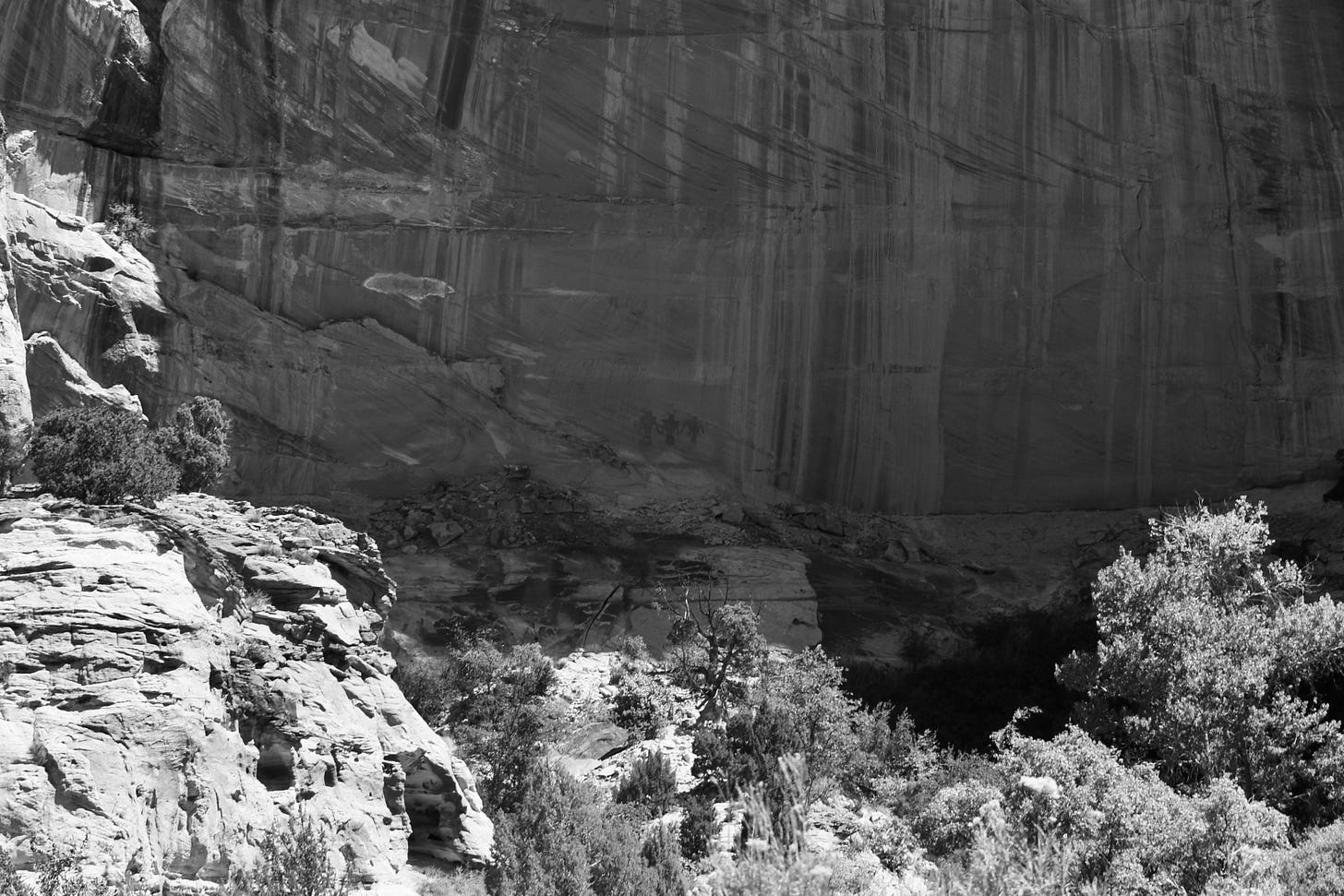
In April, after a 1,000-year-old petroglyph panel near Moab was defaced by a climber who bolted three new routes over what he’d assumed was “graffiti,” Len Necefer, a member of the Navajo Nation and founder of the group Natives Outdoors, spoke about the West’s long history of Native erasure in a video posted on Instagram. It’s a legacy that’s especially present, he noted, in the canyon country of southern Utah, where clashes between the recreation industry, extractive interests and Native tribes over issues like the establishment of Bears Ears National Monument are just the latest in a centuries-long line of conflict.
“If you look into the earliest settlement of San Juan County by white Mormon settlers in the late 1880s, there was also a commensurate boom in the university and museum industries for artifacts,” Necefer said. “What began happening is that an economy was created for Indian artifacts, and a lot of these communities, basically, made a lot of money by going out into the Bears Ears region, taking artifacts and selling them to museums.”
It was rock art alone, carved into cliff faces or large boulders, that couldn’t be easily plundered from these landscapes — though, as Necefer noted, there have been times when looters wielding saws and chisels have tried. Perhaps it’s this very lack of exploitability that provokes the vandal — if a thing can’t be seized and profited from, at least it can be destroyed, or marked. “The reason why we’ve been trying to protect these things,” said Necefer, “is because so much of the policy of this country has been to erase it.”
One of North America’s most famous rock-art sites, the pictographs at Hueco Tanks in El Paso County, Texas, makes a brief appearance in the canonical anti-Western, Cormac McCarthy’s Blood Meridian. Fittingly, in a story set a century before any petroglyphs were damaged by a power tool or flooded by a hydroelectric dam, it’s McCarthy’s personification of cosmic evil, Judge Holden, who authors the same destruction:
The rocks about in every sheltered place were covered with ancient paintings and the judge was soon among them copying out those certain ones into his book to take away with him. They were of men and animals and of the chase and there were curious birds and arcane maps and there were constructions of such singular vision as to justify every fear of man and the things that are in him. Of these etchings — some bright yet with color — there were hundreds, and yet the judge went among them with assurance, tracing out the very ones which he required. When he had done and while there yet was light he returned to a certain stone ledge and sat a while and studied again the work there. Then he rose and with a piece of broken chert he scappled away one of the designs, leaving no trace of it only a raw place on the stone where it had been.
Later, challenged by a companion about what he is “taking away” in his book, the judge rejects the notion that there are some questions that can’t be answered, some truths that will never be revealed. “The man who believes that the secrets of the world are forever hidden lives in mystery and fear,” he says. That the meaning of a pictograph would lay beyond his understanding is an affront to the judge: “Whatever in creation exists without my knowledge exists without my consent,” he warns. “This is my claim… In order for it to be mine nothing must be permitted to occur upon it save by my dispensation.” No doubt McCarthy, scowling sepulchral desert philosopher-king that he is, had in mind what to him were weightier themes than mere earthly imperialism and colonialism when writing his masterpiece, but of course the judge’s words describe precisely those things. Does he efface the pictograph at Hueco Tanks because it was the one he finally understood, or because it was the one he couldn’t? In either case, the deciphering and the erasure are just two sides of the same totalizing, annihilating acquisitiveness.
Ancient symbols, the origins of language and the line between representation and abstraction are topics of interest for McCarthy, whose only published piece of nonfiction, “The Kekulé Problem,” appeared in the science magazine Nautilus in 2017. Its title comes from the 19th-century German chemist who, after years of puzzling over the molecular structure of benzene, finally hit upon the answer — a ring shape — by dreaming of an ouroboros. Why the snake, McCarthy asks, instead of the words it’s a ring shape? “Why is the unconscious so loathe to speak to us? Why the images, metaphors, pictures?” In his telling, the sudden takeover of the human mind by language systems — whose development, roughly 100,000 years ago, is likened to a “parasitic invasion” — has created problems for a species still governed in large part by a much older, resolutely nonverbal biological operator. “The unconscious is just not used to giving verbal instructions and is not happy doing so,” McCarthy writes. “Habits of two million years duration are hard to break.”
As the essay’s title suggests, McCarthy, who spends his time among physicists and mathematicians at the Santa Fe Institute, asking “big questions,” seems chiefly concerned with what help the unconscious mind and its “picture-stories” might be in answering them. What can we dredge up from the depths of our subconscious, he wonders, that might be of use on these higher planes of inquiry, as we puzzle over problems of quantum theory or dark matter that only language has taken us to the doorstep of? But as a master of his craft, which is not drawing picture-stories but arranging words on a page, McCarthy surely understands the power of the reverse proposition: What can writing unlock in the unconscious? Language, especially written language, allows us to store, arrange and transfer between ourselves vast amounts of complex information, but what makes us think that this gives it exclusive domain over the biggest questions there are? The words that we read or hear elicit responses from our unconscious all the time. Often these responses are base expressions of primal needs, simply described: hunger, nostalgia, lust. But we all know that the best writing does something more — brings us to the edge of the inexpressible. Can you put into words what you feel when you gaze into the depths of Judge Holden’s madness, when you hear Murray Jay Siskind describe looking at the most photographed barn in America, when you think of the yellow-flagged riverboat coming and going, forever, along the Rio Magdalena? Are you sure?
The unconscious is central to the way Clifford Duncan, the Ute tribal elder, believed that the petroglyphs left behind by his ancestors are best interpreted. His suggestion to “listen to the rock art … with your soul” is the kind of advice that causes certain eyes to roll, but it’s little different from what the brightest minds at the Santa Fe Institute believe the unconscious is capable of. “Same way with books, you read books but you don’t catch it,” Duncan told Carol Patterson. “Then when you are sleeping and you wake up in the night and you say, that book said this. Then you go back to that book and say, ‘let me see that,’ and you go back to that page and it becomes clear then what that book is saying. It works that way. It’s that spirit of those words jumping into you. You never forget that after that.”
Decades of more rigorous analysis have gradually given archaeologists a better understanding of the petroglyphs and pictographs that adorn the West’s ruins. Though only a small fraction of this rock art can be said to have been “deciphered,” it’s still possible to make broad conclusions about what kind of significance it held — and the quite obvious answer is that rock art had all sorts of meanings, served all sorts of purposes. If you looked at a random assortment of 1,000 manuscripts from medieval Europe, or 1,000 web pages from the 1990s, what would you expect to find? Histories, diaries, maps, guides, prayers, fabulism, frivolity — it’s all there in the petroglyphs and pictographs of the West, too.
There are actually at least two “Newspaper Rocks,” the more famous of them in Utah and the second 200 miles south in Arizona’s Petrified Forest National Park, another large concentration of hundreds of etchings made over a period of more than a thousand years. Other such accumulations of rock art can be found at Painted Rock southwest of Phoenix, at Picture Rock in Colorado’s Shavano Valley, at Hueco Tanks, and elsewhere. These sites, with their cacophonies of symbols superimposed on one another by different tribes and cultures, are hopelessly impossible to decipher, but they’re the easiest of all petroglyphs to understand. If you doubt that, just look up or to the side, at the initials scratched out by pocketknife — signs of a simple human wish to know and be known, to feel a sense of presence and continuity with the past.
Reg Saner, the poet, essayist and University of Colorado professor, wrote briefly of Utah’s Newspaper Rock in Reaching Keet Seel, his 1998 chronicle of his wanderings among Ancestral Puebloan ruins. “The effect,” he wrote, “is a delight and a babble, like tongues of lost languages all speaking at once, tantalizing viewers with mysterious utterances right under their noses.” The site had stuck with him. A decade earlier, Saner had given it a short ekphrastic treatment in an issue of the Virginia Quarterly Review:
[I]f someone who stood here takes shape, vague
as this sage clump’s dust-colored birds,
he’s your own love of touching what’s gone.
So your daydreams of leaving some trace,
though not above nature, within, show up in him
guiding himself by the hand that outlined
two antlered deer, turkey claw, sun-spiral
chipped into dark manganese oxide—
where dozens of stick figures
old and stark as winter trees
hold their arms wide open.
Saner died in April. “The Petroglyphs at Newspaper Rock” never appeared in one of his collections, or any other anthology. It survives, all 24 lines of it, in a few yellowing copies of an old literary journal tucked away in libraries and attics, and on a little-visited, poorly-digitized archival web page that’s still live, for now. Will it last as long as long as any of the petroglyphs that inspired it have? The poem’s final stanza is a quotation, a voice from the past. “‘You may come now, alone. Or wait, / and come with the others.’” Whose voice is it? In the stillness of the canyon, is it anyone’s voice at all, or just an echo — and of what?
